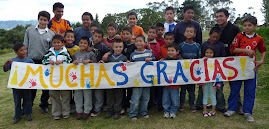That covered, they did their best to align the hole saw cuts from both sides of the workpiece, but about a third of the wheels were coming out uneven across the "tread" area. So my son, Keegan suggested that we just cut them from one side - which doesn't produce as clean a cut (ie. more tear-out), but at least the tread area is even straight across the wheel. In practice this change lead to better looking wheels, because the sanding required for the significant tear-out was easier and faster than that required to rectify the uneven tread.
So the boys cut 10 wheels apiece and sanded them off. That left about 60 wheels to go to meet our goal of assembling 50 cars.
Fabian with his 10 completed wheels.
Alex Mora with the product of his efforts.
Then Keegan and Arley Rocha worked together and cut out another 40 wheels between them. They also cut up all the axles for the rest of the cars. So at the end of the day, we're only lacking another 20 wheels before we can assemble the rest of the cars.
I've been looking for linseed oil here, which is the material specified to finish the cars in the instructions for these cars that I received from the folks in Coeur d'Alene, Idaho, who gave me the idea for these cars. Here in Colombia linseed oil would be called "aceite de linaza", but so far no joy in finding a source. At the wood-working stores and paint stores that I've checked so far, they all look at me like I'm a crazy gringo when I ask if they sell the oil here. I read on Wikipedia that linseed oil doesn't prevent mildew, so perhaps that is why it's not popular in this humid climate. So I've bought some Tung oil and some clear wood preservative to test as potential alternative finishes.
Aside from the work on the car parts, Einer continued stringing up the spokes on the new wheels for his bicycle. He did the front wheel about a week ago, and on Saturday had the chance to work on the back wheel. Only problem was getting the gear cassette off the hub. Since the cassette was so firmly attached (rusted on), we had trouble with the hub slipping in the vice while reefing on the freewheel remover. In the end, the hub was damaged because of the high force we put on it to keep it from turning with the cassette, so I gave Einer a new one to replace it. Then he could finally remove the old spokes and start installing the spokes, as shown in the photo below:
Einer stringing the spokes while Arley helps steady the wheel.
Other misc tasks we completed during the day were repair of the firewood storage rack by Arley and another coat of epoxy paint applied to the chemical pump support by me.
Not a day of big wins, rather of determination to keep moving ahead.












